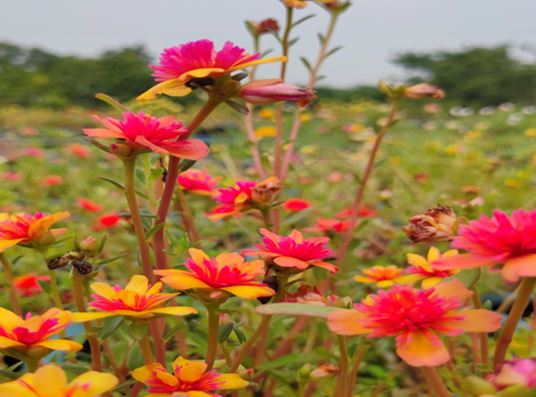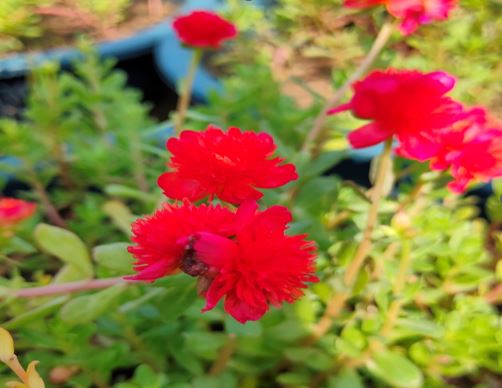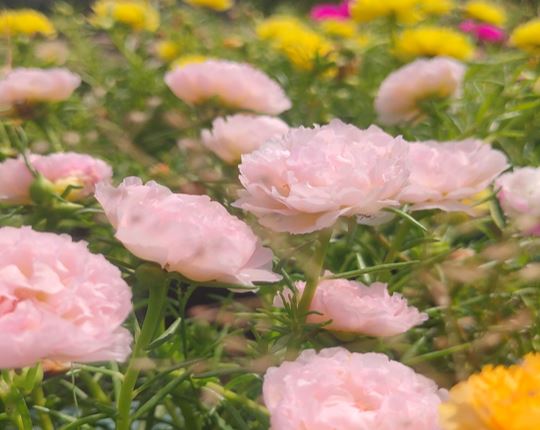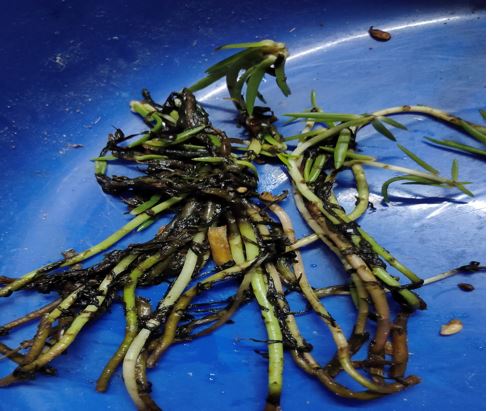
Portulaca is a type of plant which is suction and flowering and belongs to the family Portulaca Grandiflora. This Topic Discuss about Grow and Care Portulaca Plants For Portulaca Flower Farming .
The original source of this flower is mainly Uruguay, Southern part of Brazil, Argentina and shows other cultivated gardens of other countries. This flower Portulaca common names such as Moss Rose , 11’o o’clock, Rock rose, Mexican rose, Sun rose, Pathumani Chedi, Table Rose, Time Flower There are so many.
This species of roles are mainly shown also in south Asia and it was also spread all over the world almost in cities around 18th or 19th century architecture especially among the Balkans. This plant is small however it is also known as an early fast growing plant and it grows up to 30cm or less.
On the other hand if the plant is cultivated appropriately then it can easily get the actual height. The leaves of this plant are fleshy and thick and they are also approx. 2.5 centimeter long. Leaves of this plant are generally arranged in small clusters or alternatively. Those flowers generally have five letters Such as Yellow, white, Red and orange.
The long shoots, ascending or upright branches are near to the base. The range of the diameter of petals of these rose flowers is from 2.5 centimeters to three centimeter. There are many variations in the color of those petals such as pink, red, orange, yellow and white.
They are long shot; upright, ascending branches are nearly situated to the base area. The leaves are almost 2 mm to 3 mm wide and 20mm to 25 mm long. Those leaves are mainly grown towards its tip and also stalk in shape.
About Portulaca Grandiflora:
“Portulaca Grandiflora ” can be treated as highly popular flowers and sold yearly at centers of gardens in the spring season. The succulent, medium green, cylindrical leaves of “Portulaca Grandiflora” are another option to this plant’s hardiness mainly under the bearable level of drought situations.
Those plants can grow from 9 inch or 3 inch tall and also spread to make a density mat, it also makes moss rose as a good platform as a coverage ground. The colors of those flowers come with different attractive colors, including ruffled petals and also looks like miniature roses.
Those blooms can grow under clusters upon reddish stems and also it may not open at night in cloudy situations. These types of roses can be quickly and easily grown and also properly planted under the spring season, once the tough frost has overcome.
| Botanical Name | Portulaca grandiflora |
| Common Names | Moss rose, Mexican rose, Ross moss, Rock rose, Sun rose, moss-rose purslane |
| Plant type | Yearly flowering succulent |
| Mature size | From 9 inch to 3 inch tall & from 12 inch to 6 inch wide |
| Sun Exposure | Full Sun |
| Soil pH | 5.5- 7 |
| Soil Type | Well-draining, Sandy, dry moisture to average moisture |
| Bloom Time | From frost to early summer |
| Flower Color | Pink, Red, yellow, White, Orange |
| Hardiness Zones | 11 to 2 (as per yearly basis) |
| Native Area | South America |
It has found that, in most cases, those rose plants are cultivated in container areas; it also includes the front phase of the garden’s bed borders. On another side, the trailing practice of that moss rose would also perform well in any hanging baskets.

However, in most cases that moss rose may not generally spread outside of such liabilities under the phase of ground cover. Hence it is clarified that cultivation of those types of roses are appropriate for any small garden. Those rose plants can easily grow in dry, poor soils, whereas many other trees have to struggle a little bit.
Inspiring these scenarios many times wet soil or overwatering can also kill those plants. Those types of plants mainly need low levels of maintenance. Those flowers start to bloom starting from the early summer to the early frost occurring any kind of deadheading required.
One can also trim those plants near to the middle time of summer season, only if they begin to look lanky. On the other hand, those rose trees will die once this growing season has been covered. Those plants need to make seeds which might sprout and germinate in the upcoming year.
How to Grow Portulaca Plants
Moss rose can bear several types of soil, although it prefers well-drained, sandy soil and high sunlight. These rose trees are also excellent for drought tolerance and high heat and also help to spread very well.
Light: those rose plants require at least 8 hours to 6 hours of a complete sunny day to bloom and look their best. However, if anyone wants to grow that moss rose under any shady zone, those flowers would never open.
Soil: Those rose plants can thrive in Rocky and Sandy soil and also require excellent drainage. If such garden areas carry clay soil, then plant that rose moss in containers without trying to develop the drainage system of clay soil.
Water: Moss rose trees have moderate moisture to low moisture requirements, although those aren’t drought-tolerant like cacti. Those plants can easily bear the season of dryness; however flowering is mainly good along with some moisture of soil. Therefore, before planning any water one should make a plan for watering without any rainfall.
Humidity and temperature: Being a local member of Argentina, Brazil and Uruguay those roses are comfortable under low humidity and high heat. Those plants can bear the moisture and cool only if the weather is free from frost. However the best production or blooming of this type of flower would not happen until the heavy heat of summer comes along.
Fertilizer: These types of plants would easily bear the nature of lean soil; therefore this type of soil does not require any extra fertilizer. On another side, if anyone wants then he can feed those plants a slow-release and balanced fertilizer at an early stage of plantation. It would aid them to profuse flowering and bring healthy growth.
Also Read:- How To Start Pearl Farming Business
Portulaca Varieties :
It has found that this 9’o o’clock flower has lot of varieties, such as:
i) Afternoon Delight: The two inch wide blooms of this rose are open for the whole day; it also closes its blooming in the late evening.
ii) Duet Series: Those types of flowers are generally in rose and yellow or red and yellow.
iii) “fairy tale series” : Those type of flowers would resemble bomb-category peonies as those flowers are carrying a center like pom-pom along with flat petals which are flare all over its edges

iv) Sundance: The size of this flowers is large in size rather than many varieties
v) Sundial series: It can bear the cool weather and cloudy days better than several varieties and it also approaches a wide range of colors.
Growing of those Plants from the Seeds:
Before growing those moss from the seed, one needs to begin the procedure eight weeks or six weeks from the last date of frosting. On another hand, one can also project this plant in the soil once the last frost has happened. At first put the seeds into the light moist soil, and after that cover those seeds barely as they require sunlight for germinating. The germination procedure might take 2 weeks.
The moisture of soil also needs to be maintained properly until those seedlings emerge. After that only water those plants only when the upper porting of the soil is not wet. If anybody is growing those plants in indoor areas then one also needs to keep them near the proper sunlight area. On another side, mixing tiny types of seeds along with them can also make the cultivation process more uniform and easier.
How to grow Portulaca from Cuttings:
Portulaca plant is known as a self-seeding yearly plant, mainly utilized in the yard as the coverage of ground. On the other hand, the most popular two categories of this brand might not have more than two divergent usual names like pigweed, moss rose and so on. Those flowers would be easily cultivated by cutting and seeding in USDA areas from 11 to 5. Bloom’s has come from the summer season to late frost falling.

At first select any field of the garden area where sunlight reaches properly. This flower plant will grow from where it gets enough sunlight and heat. Primarily dig the soil and prepare it as per necessity, then bed the plant from 6 inch to 4 inch. After that turn the soil and break up the clods of large dirt. Then add a layer of one inch organic compost and also two inch of sand layer along with the mixture of existing top soil.
Scratch the bed of seed until it reaches to the perfect level and it also breaks up a thin phase of seeds at the top most level of the soil. The seeds should not be covered. The bed should be watered through a fine mist and make it moist, not soggy. Watering these rose plants sparingly and deeply. Watering them At least one time within a week seems to be sufficient. On the other hand, over watering those plants is also not beneficial for them, as they have a problem of root rot.
Planting The Transplants
At first cut a piece of 2 inch to 5 inch of those moss from a mother plant. Then remove the leaves from the bottom session of the cutting area. After that, prepare the bed of planting just like the seeding and then put the cutting place and bare down the stem into soil. Then press the cutting area gently into the soil to make a good connection with the base area.
Growing Portulaca in Containers:
First, select a porous pot of terra cotta or white container, so that the beauty of moss blooms does not detract. For getting the best color choice one must begin containers from the seeds. Mix tiny seeds with the sand and also spread them very easily.

Cover those seeds lightly, so that it can get enough sunlight. Seeds require proper sunlight for germination. Keep those seeds moist until those seeds germinate within 1 week to 4 weeks. Select from the new categories to the large blooms. Some of them are double flowering. One can also select from the series like “Calypso Mix”, “Mojave”, “Happy hours” and so on.
How To Grafting Portulaca:
At first cut the stem from a yellow moss rose plant and then graft it over the orange moss rose plant. One steam needs to be thicker and another one is thin. The thin steam will be put into the thick steam by creating a hole in it and giving it support through mud and keeping it tight into the soil. It also tightens by coir thread and after 4 to 5 weeks a successful joint will happen.
How to Care Portulaca:
One can check regularly for aphids, caterpillars, mealy bugs, snails and slugs. Especially in the rainy season, gray mold or botrytis blight like fungus attack can also kill this plant. The best technique for getting rid of this type of disease is one can do inspection on a regular basis and also sterilize the cutting equipment before using.
Diseases and Common pests:

Great thing found in moss roses is, they rarely get attacked by any notable disease or pest problems. Slugs and Aphids can rarely bother those plants, mainly under the spring season. Along with those aphids, one might view any sticky area on such leaves; it also indicates wilting and yellowing of such foliage. To treat such issues one can give spray by mixing insecticidal soap on affected rose plants. On the other hand, a weak drainage system might create crown rot.
How to protect portulaca plants from heavy rain:
- Checking of worms in the beds of plant
- 2.Don’t water at evening time, especially after 3 pm
- Make sure that no stagnant water is present
- Watering the plants once the beds or containers are checked well
Conclusion:
Those moss flowers are really very beautiful under several landscape settings and gardens and it also can be utilized to beautify stone walkways and old structures. Those types of moss roses seem beautiful when they grow beside a garden path or around stones. That beautiful moss rose would also aid in attracting butterflies or birds.
At the time of opening those flowers would nearly conceal the foliage. Newer hybrids and cultivars may also propose a wide assortment than the species. Some of those flowers are spotted striped with several colors also.
Each flower would carry five thin petals, however double and semi-double kinds have been cultivated along with multiple ranges of petals. Moss rose would also be known as a good beading tree under dry, hot areas where other trees have to go through some struggle.

